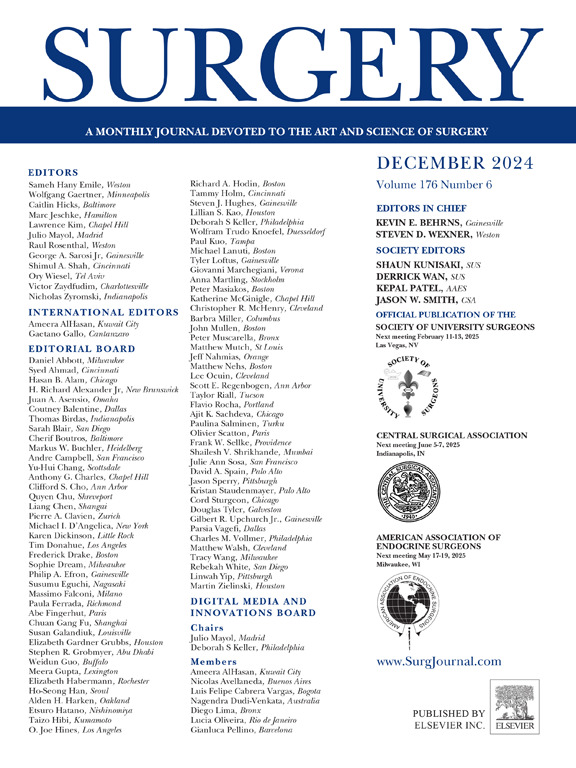开腹与腹腔镜与机器人腹股沟疝修补术:倾向匹配结果分析
IF 2.7
2区 医学
Q1 SURGERY
引用次数: 0
摘要
背景:腹股沟疝修补术是世界上最常见的外科手术之一。开腹、腹腔镜和机器人等每种修补技术都有其优势和主张。之前的研究对两种技术进行了比较,但对所有三种方法进行长期随访比较的数据很少:方法:研究人员回顾了 2007 年至 2022 年间收集的单侧腹股沟疝修补术的前瞻性数据。根据患者的年龄、性别、体重指数和侧位,对3300多例腹股沟疝修补术进行了1:1:1倾向得分匹配,分别为开放式腹股沟疝修补术、腹腔镜腹股沟疝修补术和机器人腹股沟疝修补术。我们进行了标准的描述性和比较性统计。以下数据统一按照开放式腹股沟疝修补术与腹腔镜腹股沟疝修补术、机器人腹股沟疝修补术进行报告:结果:共有 420 名患者进行了配对,每组 140 人。两组患者在年龄、体重指数或吸烟状况方面没有差异。开放式腹股沟疝修补术的合并症明显较多(2.8 vs 2.6 vs 2.3;P = .035),其中慢性阻塞性肺病(5.0% vs 0.0% vs 1.4%;P = .013)、肝硬化(4.3% vs 0.0% vs 1.4%;P = .032)和充血性心力衰竭(5.0% vs 0.7% vs 0.7%;P = .023)的发生率较高。各组之间的美国麻醉医师协会评分差异显著(III 期和 IV 期:35.0% vs 20.0% vs 28.6%;P = .004)。开放式腹股沟疝修补术的复发率更高(48.6% vs 27.9% vs 17.1%;P < .001)。两组的平均手术时间有明显差异(88.0 vs 86.1 vs 101.4 分钟;P < .001)。在伤口感染(0.7% vs 0.0% vs 0.0%;P > .99)、血肿(1.4% vs 0.7% vs 1.4%;P > .99)、需要干预的血清肿(2.9% vs 0.7% vs 0.7%;P = .377)或再入院(0.0% vs 2.1% vs 1.4%;P = .378)方面没有差异。两组患者出现长期不适(需要重新配药两次以上)的比例相似(2.9% vs 2.1% vs 2.1%;P = .903)。机器人腹股沟疝修补术的费用明显高于腹腔镜腹股沟疝修补术和开放式腹股沟疝修补术(10,005 美元 ± 7,050 美元 vs 17,155 美元 ± 6,702 美元 vs 31,173 美元 ± 8,474 美元;P < .001)。两组随访至少2.4年(3.6 vs 4.8 vs 2.4年;P < .001),复发率相当(3.6% vs 0.7% vs 0.7%;P = .226):结论:在合格的医生手中,所有技术都是安全有效的。结论:在合格的医生手中,所有技术都是安全有效的。开放式腹股沟疝修补术更常用于合并症患者和复发性疝气患者,但伤口并发症、术后长期不适和复发率相当。本文章由计算机程序翻译,如有差异,请以英文原文为准。
Open versus laparoscopic versus robotic inguinal hernia repair: A propensity-matched outcome analysis
Background
Inguinal hernia repair is one of the most common surgical procedures in the world. Each repair technique, open, laparoscopic, and robotic, has its advantages and advocates. Prior studies have compared 2 techniques, but there are little data comparing all 3 approaches with long-term follow-up.
Methods
Prospectively collected data for unilateral inguinal hernia repair between 2007 and 2022 were reviewed. Using more than 3,300 inguinal hernia repairs, a 1:1:1 propensity score match was performed for open inguinal hernia repair, laparoscopic inguinal hernia repair, and robotic inguinal hernia repair based on patient age, sex, body mass index, and laterality. Standard descriptive and comparative statistics were performed. Data below is reported consistently as open inguinal hernia repair versus laparoscopic inguinal hernia repair versus robotic inguinal hernia repair.
Results
A total of 420 patients were matched, with 140 in each group. There was no difference in age, body mass index, or smoking status between groups. Open inguinal hernia repair had significantly more comorbidities (2.8 vs 2.6 vs 2.3; P = .035), including higher rates of chronic obstructive pulmonary disease (5.0% vs 0.0% vs 1.4%; P = .013), cirrhosis (4.3% vs 0.0% vs 1.4%; P = .032), and congestive heart failure (5.0% vs 0.7% vs 0.7%; P = .023). American Society of Anesthesiologists scores differed significantly between groups (stage III and IV: 35.0% vs 20.0% vs 28.6%; P = .004). Open inguinal hernia repair were more often recurrent (48.6% vs 27.9% vs 17.1%; P < .001). The mean operative time was significantly different between groups (88.0 vs 86.1 vs 101.4 minutes; P < .001). There was no difference in wound infection (0.7% vs 0.0% vs 0.0%; P > .99), hematoma (1.4% vs 0.7% vs 1.4%; P > .99), seroma requiring intervention (2.9% vs 0.7% vs 0.7%; P = .377), or readmission (0.0% vs 2.1% vs 1.4%; P = .378). The rate of prolonged discomfort, requiring more than 2 pain medication refills, was similar between groups (2.9% vs 2.1% vs 2.1%; P = .903). Robotic inguinal hernia repair was significantly more expensive than laparoscopic inguinal hernia repair and open inguinal hernia repair ($10,005 ± $7,050 vs $17,155 ± $6,702 vs $31,173 ± $8,474; P < .001). With follow-up of at least 2.4 years in each group (3.6 vs 4.8 vs 2.4 years; P < .001), the recurrence rate was comparable (3.6% vs 0.7% vs 0.7%; P = .226).
Conclusions
All techniques are safe and effective in qualified hands. Open inguinal hernia repair was more commonly used in comorbid patients and recurrent hernias, but the techniques had comparable rates of wound complications, postoperative prolonged discomfort, and recurrence.
求助全文
通过发布文献求助,成功后即可免费获取论文全文。
去求助
来源期刊

Surgery
医学-外科
CiteScore
5.40
自引率
5.30%
发文量
687
审稿时长
64 days
期刊介绍:
For 66 years, Surgery has published practical, authoritative information about procedures, clinical advances, and major trends shaping general surgery. Each issue features original scientific contributions and clinical reports. Peer-reviewed articles cover topics in oncology, trauma, gastrointestinal, vascular, and transplantation surgery. The journal also publishes papers from the meetings of its sponsoring societies, the Society of University Surgeons, the Central Surgical Association, and the American Association of Endocrine Surgeons.
 求助内容:
求助内容: 应助结果提醒方式:
应助结果提醒方式:


